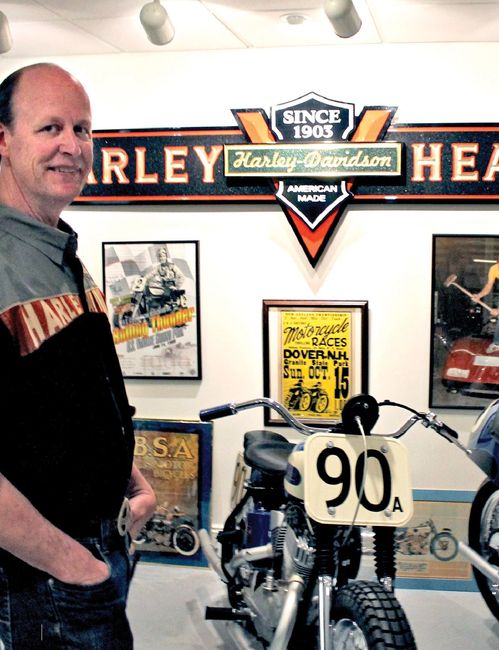
More about the Collection
“We’ve hosted hundreds of remarkable exhibits since we opened in 2007, including rare Hollywood memorabilia and costumes, and every kind of art you can imagine,” says the Center’s Executive Director Robert Nash, “but this one will take the cake. We can’t wait to open our doors to people from all over the world who love motorcycles and see them as beautiful examples of ingenuity, artistic design, and America’s love of the open road.”
“The first bike I built from scratch,” says David McGraw, who has selected the bikes for the exhibit from his vast collection. “I restored antique cars for a business and I’d always loved motorcycles … so I decided I would build one. It came out beautiful, but then a friend said, ‘You know, you put all this effort into this thing, and it’s worthless to anybody else except you because it’s not going to appreciate. So you should really restore bikes.’ So when I came across this 1928 Harley—they call it a ‘two cam’—I bought it. And that one bit me. And I started restoring them. I usually work on four to five motorcycles at once, and it takes me years sometimes to finish a bike.”
Although the collection is full of unique machines, each distinct from the next, there is a common thread. “When I finally decided that I was going to concentrate on bikes, for a collection,” McGraw says, “my father told me, ‘You’ve got to pick one thing and try to be a little distinctive,’ … so I picked racing machines, because they have a history and they’re hard to find. Usually they’re thrown away. But I wanted my collection to be the full era, from start until now, of Harley race bikes.”
McGraw has worked hard to restore the bikes in his collection, but he’s worked equally hard to learn their stories. “I bought a project from a guy in California. A sidecar racing rig. I kept trying to get this guy to tell me the history of that bike, but all he told me was that the rider was Dick Hummer. It took me three months to find him. I made twenty-five phone calls, but I finally got him. I said, ‘Are you the guy who raced the Harley sidecar in the ‘70s?’ And he said, ‘Yep, that’s me.’ He told me he was a Harley dealer who sold the record number of lightweights, so they changed the name of it to the Harley Hummer. He’s ninety something now. And he has the original engine for this bike I want … and he won’t relent. He says he promised it to his son-in-law. I told him I’d buy his son-in-law another kind of motor. Nope. But he told me I was very polite and persistent. And after three years he finally called to say he was willing to sell.”
When asked if he’s missing anything, he smiles. “There’s one that’s called the 8-valve Harley, which is the Holy Grail. Don’t have one of those.”
McGraw’s favorite bike?
“That’s a tough one. I’d say one of my favorites is the Harley two cam. I had a black one that I rode for fifteen years. I just loved the look of it … and it was Harley’s racing engine, de-tuned and put into a street bike … so right from the dealer in 1928 it could go 85 miles an hour. And in ten minutes of tuning you could hit 100. But no road could handle that back then. So it was only on a track situation. But it was very expensive. It was $390 in 1928. You could buy a very nice car for that back then.”
Although McGraw prefers a modern Harley for long-distance rides—sometimes from coast to coast and often to Sturgis and other iconic destinations—he often travels the Cape on the bikes he’s restored, and his heart belongs to the storied machines in his collection … and to the hunt for the parts he needs to restore others to their original glory. But a lot goes into the hunt.
“I look all over the place. eBay. Junk stores. I go to swap meets. I look for old bikes wherever I go. And I look at the books,” he says. “I look at the books and I study them. I have a road racer that’s a great example. It was one they really didn’t race here in the United States—it was made more for Europe but somehow it survived here. I started with just the engine and the bare frame that I found in the back of this guy’s garage. And I knew what it was the minute I saw it. Took six years to find all the other parts. Tires are hard. They always rot out. The molds still exist for almost every size tire, so you can get reproductions, but I needed the one size tire they don’t reproduce. The only thing that came close, I found, were rickshaw tires. So I used original tires. 1920s. They’re cracked. But they’re originals.”
His method, when he’s restoring a bike, is both methodical and thorough. “When I find enough parts, I amass everything I need to assemble the bike … but before I restore it I fit everything, do the body work, then take it all apart, clean it up, paint and polish, plating, and then put it all together again.”
Likewise, the artwork on the walls during Art on Two Wheels is from a collection assembled with great care and patience. “All the artwork, with the exception of a few things, is original artwork. I see things over the years, and I barter or buy all kinds of artwork and memorabilia.” The results are incredible and include a cornucopia of paintings, posters, signs, and artifacts.
Copyright © 2019 Art on Two Wheels - Cultural Center of Cape Cod - All Rights Reserved.